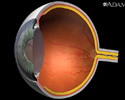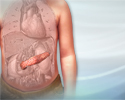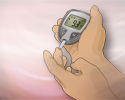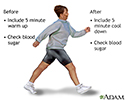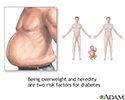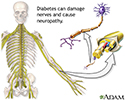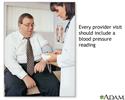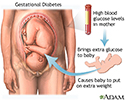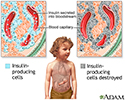Diabetes
Diabetes - type 1; Diabetes - type 2; Diabetes - gestational; Type 1 diabetes; Type 2 diabetes; Gestational diabetes; Diabetes mellitusDiabetes is a long-term (chronic) disease in which the body cannot regulate the amount of sugar in the blood.
The Basics
A Closer Look
Self Care
Talking to your MD
Diabetes - Animation
Diabetes
Animation
Diabetes - retinal conditions - Animation
Diabetes - retinal conditions
Animation
Type 1 diabetes - Animation
Type 1 diabetes
Animation
Type 2 diabetes - Animation
Type 2 diabetes
Animation
Diabetes - Animation
Diabetes
Animation
Diabetes and exercise
A person with type 2 diabetes can use exercise to help control their blood sugar levels and provide energy their muscles need to function throughout the day. By maintaining a healthy diet and sufficient exercise, a person with type 2 diabetes may be able to keep their blood sugar in the normal non-diabetic range without medicine.
Diabetes and exercise
illustration
Diabetes risk factors
Type 1 diabetes usually begins in childhood, and type 2 diabetes typically begins in adulthood. Type 2 diabetes is becoming more common due to the growing number of older Americans and an increasing trend toward obesity and a sedentary lifestyle. Without proper management of diabetes, long-term health risks such as heart disease, stroke, and kidney failure can occur.
Diabetes risk factors
illustration
Diabetes and nerve damage
Diabetes can damage the nerves and cause a complication called neuropathy. This generally begins as loss of sensation in the toes, and possibly fingers. Eventually, the neuropathy can move up the person's legs or arms. Nerve damage results in decreased ability to feel pain, pressure, and extremes of temperature.
Diabetes and nerve damage
illustration
Diabetes and blood pressure
People with diabetes have a higher risk for heart attacks, strokes, and kidney disease. Your doctor or nurse should check your blood pressure at every visit. Ask your doctor what your target blood pressure is as it may differ from people without diabetes. Exercising (such as walking), eating low-salt foods, and losing weight (if you are overweight) can lower your blood pressure. If your blood pressure is too high, your doctor will prescribe drugs to lower it.
Diabetes and blood pressure
illustration
Gestational diabetes
Gestational diabetes is defined as glucose intolerance during pregnancy. During your pregnancy, hormonal changes can cause the body to be less sensitive to the effect of insulin. These changes can lead to high blood sugar and diabetes. High blood sugar levels in pregnancy are dangerous for both mother and baby.
Gestational diabetes
illustration
Type I diabetes
In response to high levels of glucose in the blood, the insulin-producing cells in the pancreas secrete the hormone insulin. Type I diabetes occurs when these cells are destroyed by the body's own immune system.
Type I diabetes
illustration
Insulin production and diabetes
Insulin is a hormone produced by the pancreas that is necessary for cells to be able to use blood sugar.
Insulin production and diabetes
illustration
Diabetes - Animation
Diabetes
Animation
Diabetes - retinal conditions - Animation
Diabetes - retinal conditions
Animation
Type 1 diabetes - Animation
Type 1 diabetes
Animation
Type 2 diabetes - Animation
Type 2 diabetes
Animation
Diabetes - Animation
Diabetes
Animation
Diabetes and exercise
A person with type 2 diabetes can use exercise to help control their blood sugar levels and provide energy their muscles need to function throughout the day. By maintaining a healthy diet and sufficient exercise, a person with type 2 diabetes may be able to keep their blood sugar in the normal non-diabetic range without medicine.
Diabetes and exercise
illustration
Diabetes risk factors
Type 1 diabetes usually begins in childhood, and type 2 diabetes typically begins in adulthood. Type 2 diabetes is becoming more common due to the growing number of older Americans and an increasing trend toward obesity and a sedentary lifestyle. Without proper management of diabetes, long-term health risks such as heart disease, stroke, and kidney failure can occur.
Diabetes risk factors
illustration
Diabetes and nerve damage
Diabetes can damage the nerves and cause a complication called neuropathy. This generally begins as loss of sensation in the toes, and possibly fingers. Eventually, the neuropathy can move up the person's legs or arms. Nerve damage results in decreased ability to feel pain, pressure, and extremes of temperature.
Diabetes and nerve damage
illustration
Diabetes and blood pressure
People with diabetes have a higher risk for heart attacks, strokes, and kidney disease. Your doctor or nurse should check your blood pressure at every visit. Ask your doctor what your target blood pressure is as it may differ from people without diabetes. Exercising (such as walking), eating low-salt foods, and losing weight (if you are overweight) can lower your blood pressure. If your blood pressure is too high, your doctor will prescribe drugs to lower it.
Diabetes and blood pressure
illustration
Gestational diabetes
Gestational diabetes is defined as glucose intolerance during pregnancy. During your pregnancy, hormonal changes can cause the body to be less sensitive to the effect of insulin. These changes can lead to high blood sugar and diabetes. High blood sugar levels in pregnancy are dangerous for both mother and baby.
Gestational diabetes
illustration
Type I diabetes
In response to high levels of glucose in the blood, the insulin-producing cells in the pancreas secrete the hormone insulin. Type I diabetes occurs when these cells are destroyed by the body's own immune system.
Type I diabetes
illustration
Insulin production and diabetes
Insulin is a hormone produced by the pancreas that is necessary for cells to be able to use blood sugar.
Insulin production and diabetes
illustration
Diabetes
Diabetes - type 1; Diabetes - type 2; Diabetes - gestational; Type 1 diabetes; Type 2 diabetes; Gestational diabetes; Diabetes mellitusDiabetes is a long-term (chronic) disease in which the body cannot regulate the amount of sugar in the blood.
The Basics
A Closer Look
Self Care
Talking to your MD
Diabetes
Diabetes - type 1; Diabetes - type 2; Diabetes - gestational; Type 1 diabetes; Type 2 diabetes; Gestational diabetes; Diabetes mellitusDiabetes is a long-term (chronic) disease in which the body cannot regulate the amount of sugar in the blood.
The Basics
A Closer Look
Self Care
Talking to your MD
Review Date: 1/10/2025
Reviewed By: Sandeep K. Dhaliwal, MD, board-certified in Diabetes, Endocrinology, and Metabolism, Springfield, VA. Also reviewed by David C. Dugdale, MD, Medical Director, Brenda Conaway, Editorial Director, and the A.D.A.M. Editorial team.

